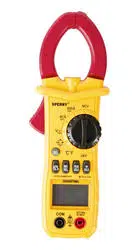Loading ...
Loading ...
Loading ...

6
5-3. DC Voltage
1. Install the test leads
2. Rotate the dial to the position
3. Confirm DC V is displayed on the LCD screen
4. If DC V is not displayed press the SEL key to toggle between ACV and DCV
5. Connect the test leads to the circuit
6. The DC voltage will be displayed on the LCD screen
5-4. AC Voltage
1. Install the test leads
2. Rotate the dial to the position
3. Confirm AC V is displayed on the LCD screen
4. If AC V is not displayed press the SEL key to toggle between DCV and ACV
5. Connect the test leads to the circuit
6. The AC voltage will be displayed on the LCD screen
5-5. AC Current
1. Remove the test leads
2. Rotate the dial to the 60Ã or 600Ã position
3. Press the trigger to open the clamp jaws and place the jaws around a single conductor.
4. The current flowing through the conductor will be displayed on the LCD screen
5-6. Frequency
1. Set up the meter for an AC voltage or current measurement and press the Hz% button
2. "Hz" should be displayed on the LCD screen
3. Connect the test leads probes to the circuit
2. The meter will display the measured frequency on the LCD screen
5-7. Duty cycle
1. Set up the meter for an AC voltage or current measurement and press the Hz% button
2. "Hz" should be displayed on the LCD screen
3. Press the Hz% button a second time and "%" should be displayed
4. The meter will display the measured duty cycle on the LCD screen
5-8. Inrush
1. Remove the test leads
2. Rotate the dial to the 60Ã or 600Ã position
3. Press the INR/REL button for 2 seconds or more
4. Confirm "INRUSH" is displayed on the LCD screen
5. Turn off the device of which you will be checking the inrush current
5-2. Resistance / Continuity / Diode / Capacitance
Resistance
1. Install the test leads
2. Rotate the dial to the position
3. Confirm “OL” is displayed on the LCD screen
4. Short the tips of the test leads together and
confirm the LCD screen shows near zero
5. Connect the test leads across the device
to be tested
6. The resistance of the device will be displayed
on the LCD screen
Continuity
1. Install the test leads
2. Rotate the dial to the position
3. Press the SEL button to toggle through the functions
until is displayed on the LCD screen
4. Confirm “OL” is displayed on the LCD screen
5. Short the tips of the test leads together and the LCD screen
should show near zero and the meter should emit a tone
6. Connect the test leads across the device to be tested
7. A tone will be emitted if the resistance is < 50Ω
Diode test
1. Install the test leads
2. Rotate the dial to the position
3. Press the SEL button to toggle through the functions
until is displayed on the LCD screen
4. Confirm “OL” is displayed on the LCD screen
5. Connect the test leads probes to the anode and
cathode of the diode
6. Record the measurement displayed
7. Reverse the connections and record the
measurement displayed
(The LCD screen should show ”OL” in one direction and a small
forward voltage drop in the other. The forward voltage drop
varies. Typical values are .7V for silicon diodes and .3V for
geranium diodes. Please refer to the diode datasheet for specific
values. If there is a voltage drop in both directions the diode is
shorted. If “OL” is displayed in both directions the diode is open)
Capacitance
1. Remove the capacitor from the circuit
2. Ensure that the capacitor is properly discharged
3. Install the test leads
4. Rotate the dial to the position
5. Press the SEL button to toggle through the functions
until "nF" is displayed on the LCD screen
6. Connect the test leads to the capacitor terminals. (It will take
a few seconds for the capacitance to be displayed)
Loading ...
Loading ...
Loading ...
